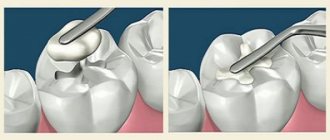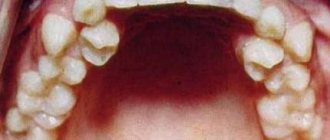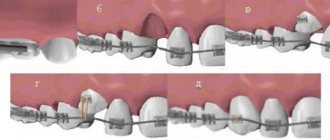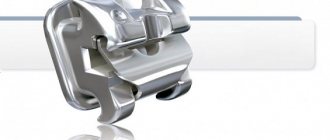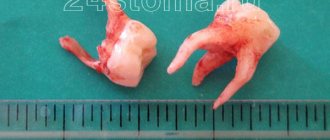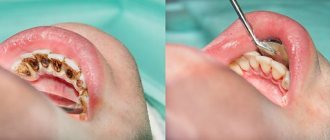Luxators ML series
Caution: Luxators have thin blades and are not intended for twisting movements. Used only for cutting the periodontal ligament. Excessive force will damage the luxator blades.
Description:
Luxators provide atraumatic extraction while maintaining the integrity of the cortical plate of the alveolar ridge and the shape of the tooth socket.
The concave inner surface follows the shape of the tooth, the sharp and thin cutting edges effectively trim the periodontal ligament.
The anatomical handle coated with aluminum oxide allows you to easily and quickly carry out the most complex removals, which is especially important for implantation purposes.
Peculiarities:
- thin blade of anatomical shape;
- atraumatic extraction;
- reliable control of the tool and comfort of work thanks to the anatomical shape of the handle;
- effective combination with removal tools.
The procedure for working with luxators:
- The luxator blade is inserted axially between the tooth root and the bone tissue of the socket.
- The immersion depth of the blade is about two-thirds of the length of the tooth root.
- The periodontal ligament is cut through light translational and pendulum movements of the luxator blade in a circle along the tooth root. Avoid twisting movements.
- Once the periodontal ligament has been completely cut with the luxator, carefully remove the tooth from the socket using an elevator or forceps.
ME series elevators
Attention: Before starting work with elevators, it is recommended to use luxators and periotomes in order to completely cut the periodontal ligament, which will ensure an atraumatic removal process. Excessive force will damage the elevator blades.
Description:
- A thin, sharp blade made of high-quality steel ensures atraumatic extraction while maintaining the integrity of the cortical plate of the alveolar ridge.
- The concave inner surface follows the shape of the tooth root; sharp and thin cutting edges trim the periodontal ligament.
- The anatomical handle coated with aluminum oxide provides reliable control of the instrument in the hand, reduces the load and stress on the hand and allows you to easily and quickly carry out the most complex removals.
Peculiarities:
- thin blade of anatomical shape;
- atraumatic extraction;
- reliable control of the tool and comfort of work thanks to the anatomical shape of the handle;
- effective combination with removal tools.
Operating procedure for elevators:
- The luxator blade is inserted axially between the tooth root and the bone tissue of the socket.
- The immersion depth of the blade is about two-thirds of the length of the tooth root.
- The periodontal ligament is cut through light translational and pendulum movements of the luxator blade in a circle along the tooth root. Avoid twisting movements.
- Once the periodontal ligament has been completely cut with the luxator, carefully remove the tooth from the socket using an elevator or forceps.
Elevators of the RET, RTP, RTE series
Attention: Before starting work with elevators, it is recommended to use luxators and periotomes in order to completely cut the periodontal ligament, which will ensure an atraumatic removal process. Excessive force will damage the elevator blades.
Description:
A thin, sharp blade made of high-quality steel ensures atraumatic extraction while maintaining the integrity of the cortical plate of the alveolar ridge.
The concave inner surface follows the shape of the tooth root; sharp and thin cutting edges trim the periodontal ligament.
The anatomical handle provides reliable control of the instrument in the hand, reduces the load and stress on the hand and allows you to easily and quickly carry out the most complex removals.
Peculiarities:
- thin blade of anatomical shape;
- atraumatic extraction;
- reliable control of the tool and comfort of work thanks to the anatomical shape of the handle;
- effective combination with removal tools.
Operating procedure for elevators:
- The luxator blade is inserted axially between the tooth root and the bone tissue of the socket.
- The immersion depth of the blade is about two-thirds of the length of the tooth root.
- The periodontal ligament is cut through light translational and pendulum movements of the luxator blade in a circle along the tooth root. Avoid twisting movements.
- Once the periodontal ligament has been completely cut with the luxator, carefully remove the tooth from the socket using an elevator or forceps.
General overview
The main types of dental surgical instruments include scalpels, curettes, scissors, forceps, elevators, clamps and tweezers.
A dental elevator (or lift - from the Latin Elevator - lifting) is the second most popular surgical instrument after forceps.
It is an oblong (150-160 mm long, 10-20 mm thick) structure, consisting of a working and intermediate part, and a handle. The working part is called “cheeks”.
Elevators are used to remove roots and their fragments, as well as dystopic or damaged teeth that cannot be removed with the main extraction tool - forceps.
During the removal process, the elevator performs the following manipulations:
- The tooth or root being removed is loosened (luxurized - from the Latin Luxatio - displacement).
- They dislocate it, that is, they break the connection of the tooth or root with the periodontal ligament.
- It is completely turned out of the hole or, as a last resort, transferred to a position in which it becomes possible to grasp it with forceps.
Elevators must meet the following requirements:
- Be strong, able to withstand the force applied by the surgeon without breaking or bending. And at the same time light, not causing fatigue in the hand.
- Ergonomic, easy to hold and well balanced.
- Have a non-slip handle.
- Be minimally traumatic to the alveolar bone and soft tissues.
An additional advantage of elevators is color coding, which makes tool selection easier.
Depending on their configuration, lifts have different shapes and technological capabilities.
Their main differences include the following:
- The position of the cheek relative to the intermediate part. The working part can be located on the same line with the intermediate one, or have an inclination relative to it.
- Cheek shape. Characterized by a large number of designs.
Most often, the cheeks have the form of a symmetrical or asymmetrical groove with pointed edges of a rectangular, round or spear-shaped configuration. The width of the cheeks is usually from 3 to 5 mm, but it can be smaller.The pointed part may have serrations that keep the tool from sliding off the fragment being removed.
- The shape of the handle and its position relative to the intermediate part.
The handle can be a continuation of the intermediate part and be in line with it, or located perpendicular to it or at some arbitrary angle.
Elevators are made of alloyed stainless steel, the requirements for which are regulated by GOST 30208-94 and R 50328.1-92.
Examples of steel grades for lifts include 30X13, 20X13, 45X14.
Operating principle of luxators
The removal process is an event that can cause stress for both the client and the attending physician. Sometimes the operation is quite problematic, this happens for the following reasons:
- manipulations may be complicated due to the location of the roots relative to the bone;
- Regardless of the condition of the damaged tooth, the periodontal ligament holds it firmly;
- Until the hole is filled with air or blood, atmospheric pressure will exert an influence that will create significant difficulties during extraction.
To eliminate these complications and achieve atraumatic removal, dentists use luxators. The tool allows you to carry out manipulations quite easily and as safely as possible. For a specific root, a luxator of the required size is selected, the working part of which is inserted under the gum at a set angle.
Ease of penetration is achieved thanks to the awl-shaped design of the tool. As a result of the impact, the doctor expands the tooth socket and separates the tissue, removing the vacuum that interferes with removal. If you need to extract a unit with one root, then no other tools are used during the manipulation process.
During the operation, the dentist gently rocks the luxator, which ensures precise insertion and also eliminates the possibility of it slipping. This device makes the dentist’s work easier; as a result, a small wound is formed, which guarantees faster healing.
Types and purpose
The main types of elevators include straight, angular and bayonet-shaped. Some instruments belonging to the listed types are named after their developers - Lecluse, Barry, Vint, Pott elevators.
Straight
The main feature of direct elevators is the location of the intermediate and working parts on the same line.
Cheek – standard configurations: oval, rectangular or bayonet-shaped, pointed edges, presence or absence of notches.
Straight models are usually used to remove maxillary single roots, dystopic teeth, and lower wisdom teeth.
Technology of use: wedging the cheek between the walls of the alveolus and the root with a groove towards the root to be removed, deepening the instrument with a rotational movement, pushing out, everting the tooth fragment from the alveolar socket to a position convenient for gripping with forceps.
What is an alvostasis sponge and for what purposes is it used in dentistry.
Come here if you are interested in indications for suturing a tooth socket.
At this address https://zubovv.ru/hirurgiya/udalenie-zubov/stomatologicheskogo-shovnogo-materiala.html we will consider modern dental suture materials.
Angular
True to its name, the angular type of tool has a bend of the cheek in relation to the intermediate part of approximately 120°. The bend can have a different direction - “away from you” or “towards you”. The most common cheek width is 3-5 mm.
Angle elevators are usually used to remove roots, teeth with a damaged crown or dystopic units from the lower jaw.
The standard method of use involves inserting the cheek between the alveolar wall and the root or between two roots with the concave part facing the fragment to be removed.
Then rotational movements are made to break the connection between it and the periodontium, dislocation (pushing out) of the root for capture with forceps.
Angular tools include the famous Winter, Barry, and Pott elevators.
Bayonet-shaped
In bayonet-shaped lifts, which are straight in configuration, the cheek is pointed in the form of a bayonet. It has a flat surface on one side and a convex surface on the other. The most famous design of this type is the Lecluse elevator.
One of the purposes of the bayonet-shaped instrument is to remove mandibular “eights”. Standard use involves inserting the cheek with a flat surface towards the root or tooth being removed, and a rounded surface towards the adjacent one.
At the same time, attention is paid to preventing dislocation of the adjacent tooth when separating and everting a tooth or root.
How a tooth root is removed in our clinic
A mandatory step in this procedure is the administration of local anesthesia. Typically, the pain relief lasts for several hours, and you will not experience any discomfort during the removal. After removal, a course of antibiotics is usually prescribed. As for the root removal process itself, the surgeon’s actions and the choice of instrument largely depend on the following circumstances:
- how deep is the root of the tooth;
- where the tooth is located: on the upper or lower jaw;
- are there pathological changes in the tissues around it, etc.
Important nuances when working with the tool
The first thing you need to do when working with an elevator is to make sure that the choice of tool is justified and that the tooth cannot be removed with forceps.
It is necessary to carefully examine the crown to determine its ability to withstand the pressure of the forceps without destruction. If the remains of the crown interfere with removing the tooth with an elevator, it must be bitten off.
The disadvantage of direct elevators is that the cheek is too massive , preventing its deep penetration into the periodontal fissure.
To compensate for this drawback, before inserting the elevator, it is recommended to use a fissure bur to form a gap between the alveolar wall and the root.
As another measure to combat this deficiency, grinding of the cheek can be used to make it thinner and sharper.
The types of elevators are not limited to straight, corner and bayonet-shaped. There are many others that may be optimal in certain clinical situations.
To remove small root fragments, for example, it is convenient to use an elevator with thin cheeks located either on one side of the intermediate part or on two.
In general, the shape of dental lifts changes over time. Some become rarely used and are replaced by others.
In particular, an elevator known as a “goat leg”, in which the working part is curved along a plane, was previously widely used.
“If only I had a goat’s leg,” the hero of A. Chekhov’s story “Surgery” mutters sadly after an unsuccessful attempt to remove a tooth.
Modern Easy Graft material for simplified and high-quality dental treatment.
In this publication, we will consider the reasons for the development of exostosis after tooth extraction.
Here https://zubovv.ru/hirurgiya/udalenie-zubov/posle-ostalsya-oskolok.html find out whether a splinter may remain after tooth extraction.
Removing a tooth root using forceps
First, the doctor separates the periodontal tissue from the root so that the exposed part of the root can be easily grabbed with forceps. If this is difficult to do, the doctor separates the periosteum and the edge of the mucosa from the socket. It is much more difficult to remove upper teeth than lower teeth, so bayonet-shaped and S-shaped forceps are used for this. The doctor places the instrument as tightly as possible and makes rotational movements with it. If the tissues surrounding the tooth are affected by an inflammatory process, then the problematic root can be extracted quite quickly. The most difficult teeth in this regard are the canines and lower molars, since they have large alveolar processes.
Possible complications
Any surgical operation, even something as seemingly simple as tooth extraction, can result in complications.
If we talk about the negative consequences of tooth extraction, which are determined by the type of instrument used (in our case, an elevator), then these include the following:
- Injury to the cheek of soft tissues. This is not such a rare case, since the working part of the instrument is sharp, and significant force is applied to it, which is necessary to loosen and extract the tooth fragment.
- Bleeding caused by damage to a large vessel.
- Infection of the hole with a poorly sterilized elevator. Sterilization of surgical instruments should be treated with great care.
When it comes to dental instruments, there is a specific sterilization protocol, the strict implementation of which helps to avoid infection of the patient. - Luxation of an adjacent tooth, used as a support when applying force to the elevator.
Since the instrument is a simple double-armed lever, it requires a support, which is used as the tooth adjacent to the tooth being removed.If excessive force is applied to the elevator, the abutment tooth may dislocate.
- Damage to the follicle of a permanent tooth. Sometimes it happens when removing the “milk jug”, under which there is an embryo of a permanent tooth.
The risk of damage increases due to the fact that the dental septum in the mixed dentition has not yet gained sufficient hardness. - The tip of the elevator breaks off and gets stuck in the alveolar socket.
- Fracture of the alveolar ridge. The most rare, but sometimes still occurring complication caused by excessive application of force to the instrument.
Most of the above complications can be attributed to the conscience of the doctor who allowed them.
Although there may be objective reasons, which include the individual characteristics of the dental apparatus of a particular patient.
The video provides additional information on the topic of the article.
Reviews
In most cases, tooth extraction is performed using forceps. However, with a badly damaged crown, when there is no way to reliably grasp it with forceps, dental surgeons resort to the help of an elevator.
In essence, due to anesthesia, the patient does not feel much difference when removing a tooth with forceps or a lift. Not counting, perhaps, the duration of the operation (the tooth is removed faster with forceps).
If you had a tooth removed using an elevator, tell us about your feelings during and after the operation. The comment form is at the bottom of this page.
If you find an error, please select a piece of text and press Ctrl+Enter.
Tags dentist tools tooth extraction
Did you like the article? stay tuned
No comments yet

